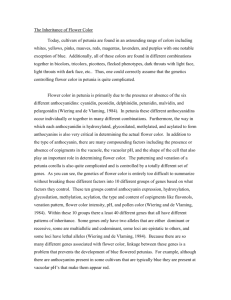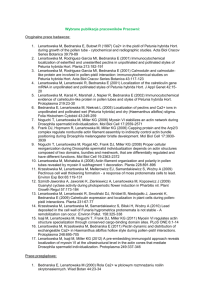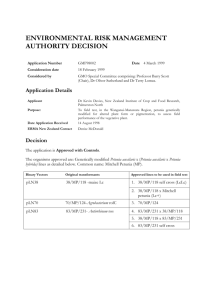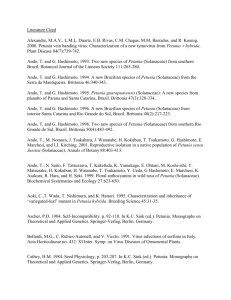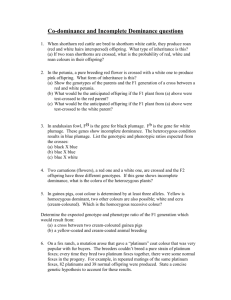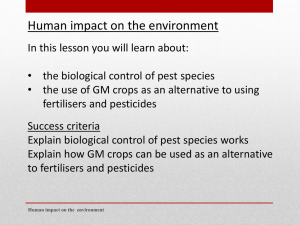A Breeding Program for Petunia hybrida
advertisement
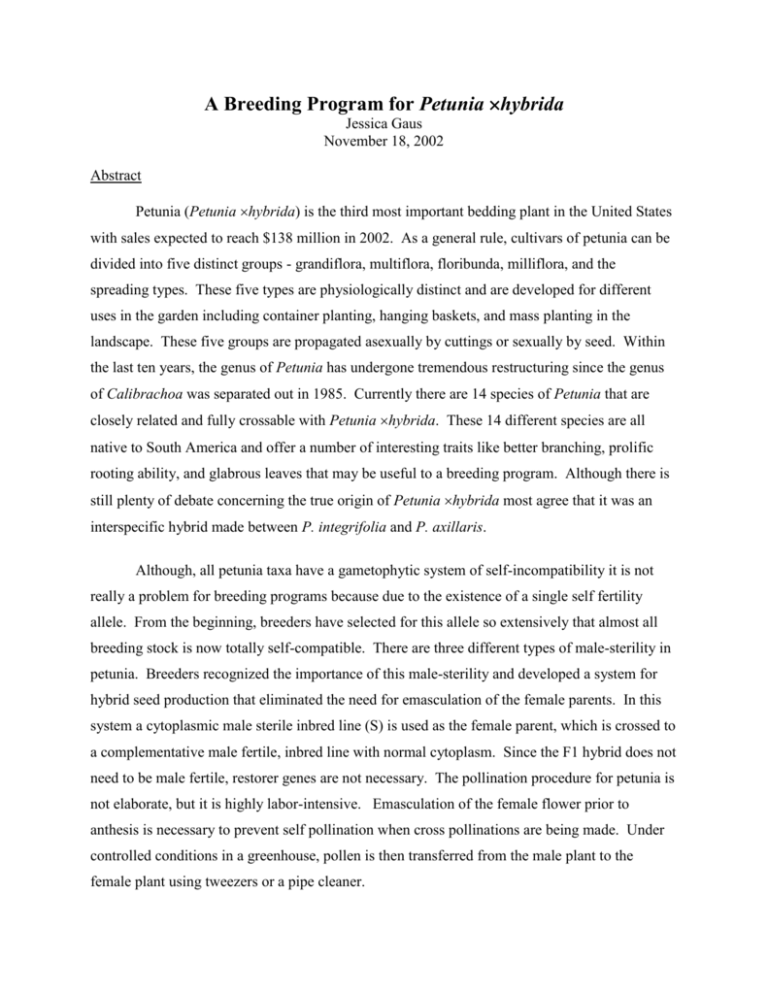
A Breeding Program for Petunia hybrida Jessica Gaus November 18, 2002 Abstract Petunia (Petunia hybrida) is the third most important bedding plant in the United States with sales expected to reach $138 million in 2002. As a general rule, cultivars of petunia can be divided into five distinct groups - grandiflora, multiflora, floribunda, milliflora, and the spreading types. These five types are physiologically distinct and are developed for different uses in the garden including container planting, hanging baskets, and mass planting in the landscape. These five groups are propagated asexually by cuttings or sexually by seed. Within the last ten years, the genus of Petunia has undergone tremendous restructuring since the genus of Calibrachoa was separated out in 1985. Currently there are 14 species of Petunia that are closely related and fully crossable with Petunia hybrida. These 14 different species are all native to South America and offer a number of interesting traits like better branching, prolific rooting ability, and glabrous leaves that may be useful to a breeding program. Although there is still plenty of debate concerning the true origin of Petunia hybrida most agree that it was an interspecific hybrid made between P. integrifolia and P. axillaris. Although, all petunia taxa have a gametophytic system of self-incompatibility it is not really a problem for breeding programs because due to the existence of a single self fertility allele. From the beginning, breeders have selected for this allele so extensively that almost all breeding stock is now totally self-compatible. There are three different types of male-sterility in petunia. Breeders recognized the importance of this male-sterility and developed a system for hybrid seed production that eliminated the need for emasculation of the female parents. In this system a cytoplasmic male sterile inbred line (S) is used as the female parent, which is crossed to a complementative male fertile, inbred line with normal cytoplasm. Since the F1 hybrid does not need to be male fertile, restorer genes are not necessary. The pollination procedure for petunia is not elaborate, but it is highly labor-intensive. Emasculation of the female flower prior to anthesis is necessary to prevent self pollination when cross pollinations are being made. Under controlled conditions in a greenhouse, pollen is then transferred from the male plant to the female plant using tweezers or a pipe cleaner. Although, petunia breeding programs have existed for over 100 years, little information has been recorded regarding the qualitative and quantitative inheritance of most traits. Today, there is only information available regarding traits like floral longevity, plant height, flowering time, flower size, and leaf variegation. The genetics and the biochemistry of flower color are astoundingly complicated. The entire system is broken down into ten different groups of genes that control different aspects of flower color in the flower like anthocyanins, hydroxylation, glycosilation, methylation, acylation, flavonols, venation patterns, flower color intensity, pH, and pollen colors. Within these 10 groups there a least 40 different genes that all have different patterns of inheritance. Petunia cultivars are usually fairly insect resistant, however they often have problems with disease caused by Pythium, Rhizoctonia, powdery mildew, Sclerotinia, and Botrytis either during greenhouse production or in the landscape. Additionally, virus infection has recently become a serious problem now that so many petunia cultivars are being vegetatively propagated. Most breeding systems for petunia closely resemble a pedigree system with selection occurring both in the greenhouse in the pack stage and in the field. Due to the recent explosion in the number of different types of petunia, selection for different environments is becoming increasingly important. Breeders must now select for superior performance in several different types of environments including the pack, containers, hanging baskets, and in a landscape planting. Inbreeding depression is a problem is a problem with petunia since it is a natural outcrosser. To avoid the loss of vigor associated with inbreeding depression, mass and full-sib selection is often used within a family late in the program (F6, F7). Introduction Petunia hybrida is divided into five distinct groups - grandiflora, multiflora, floribunda, milliflora, and the spreading types (Corr, 1998; Dole and Wilkins, 1999; Ewart, 1984; Kessler, 1998). Typically, single grandiflora petunias have large flowers (3.5-5 inches across) which are often ruffled or fringed, a coarse plant habit, broad leaves, thick peduncles and sepals, and thick anther filaments. Multiflora petunias have a more delicate overall phenotype with smaller flowers (1.5-2 inches across), narrower sepals, finer anther filaments, a more compact growth habit, and better disease resistance. The floribunda type is the result of a cross between grandiflora and multiflora types that resulted in an intermediate phenotype, which shares characteristics associated with both parents. In general, floribundas offer the disease tolerance of multifloras with larger flowers (3 inches across). Milliflora petunias are a miniature version of a standard petunia that was introduced in 1996. Millifloras are usually quite compact with plant heights and widths of only 6 to 8 inches across with 1 inch flowers (Kessler, 1998). Due to their small size, milliflora petunias are best suited for use in small containers. The spreading or trailing type of petunia is a totally new type of petunia that has become quite popular since its debut in 1992. Initially, trailing petunias were developed in Japan by Suntory Ltd. in cooperation with Keisei Rose Co. by crossing Petunia hybrida with an unknown South American species (Rader, 1998). This type is the most vigorous and floriferous of all types of petunia making it ideal for use as a ground cover in the landscape. The trailing type of petunia can be divided again into several more groups depending on whether they are produced by seed or from vegetative cuttings. Additionally, all five types of petunia are available in a double flowering version. Floricultural sales of cut flowers, potted flowering plants, and bedding plants in the United States reached $4.8 billion in 2002. This was a 58% increase from ten years ago. These estimates correspond to an average purchase of $44 per household. Sales of petunia flats are expected to total over $138 million in 2002, making petunia the third most important bedding plant behind geraniums and impatiens (Jerardo, 2002). Petunias are planted in containers, window boxes, hanging baskets, and in mass plantings in the landscape. They are sold either by seed or by vegetative cuttings in all fifty states, and are produced all over the world. Currently there are at least 10 large, privately owned companies that have petunia breeding programs including: PanAmerican Seed, Goldsmith, American Takii, Bodger, Sakata Seeds, Flower Fields, and Ball Flora Plant. Taxonomy Kingdom Subkingdom Superdivision Division Class Subclass Order Family Genus species Plantae Tracheobionta (vascular plants) Spermatophyta (seed plants) Magnoliophyta (flowering plants) Magnoliopsida (dicotyledons) Asteridae Solanales Solanaceae Petunia hybrida Biogeography The geographic origin of Petunia is South America, where various species have been found in Argentina, Brazil, Bolivia, Paraguay, and Uruguay. The hot spots for species diversity are mostly limited to the three Brazilian provinces of Parana, Santa Catarina, and Rio Grande do Sul particularly along river banks and isolated areas (Sink, 1984). Early Taxonomic Work Jussieu first established the genus Petunia in 1803. Since that time, the genus of Petunia has undergone constant restructuring and is still somewhat unsettled today. Fries wrote the first Petunia monograph in 1911 where he proposed the division of the genus Petunia into 2 distinct subgenera, Pseudonicotiana and Eupetunia. Species in the subgenera of Pseudonicotiana had long, narrow corolla tubes, while species in the subgenera of Eupetunia had short, wide corolla tubes (Sink, 1984). In 1985, Wijsman and de Jong recognized two distinct groups of genetically isolated species within the genus, Petunia, and separated them into two different genera, Petunia and Calibrachoa. Wijsman and de Jong distinguished the two different groups based on the following characters: Calibrachoa – 2n = 18, small shrubs with woody stems, flower limbs were white or purple with yellow or pale corolla tubes; and Petunia – 2n = 14, large herbaceous plants, with flowers which were either entirely white or purple (Wijsman and de Jong, 1985; Stehmann and Semir, 1997). Today the two genera of Calibrachoa and Petunia each contain 25 and 15 species respectively (Watanabe et al., 1999). Although species of these two distinct genera are often found growing in the same regions in Argentina, Brazil, and Uruguay, no naturally occurring intergeneric hybrids have ever been reported (Ando et al., 2001). Furthermore, artificial crosses between selected species of these two genera have never been successful (Ando et al., 2001). This evidence strongly suggests that genetic isolation exists between Calibrachoa and Petunia species. Because these two genera are not sexually compatible, other non-conventional techniques must be developed in order to be able to transfer genetic material between the two. Parents of Petunia hybrida The cultivated garden petunia, Petunia hybrida is not a true species but actually a complex interspecific hybrid of two or more Petunia species. In earlier literature, many taxonomists and scientists suggested that as many as 5 different species including P. axillaris, P. integrifolia, P. parodii, P. inflata, and P. violacea all contributed to the origin of P. hybrida. These theories were made increasingly complicated as the genus of Petunia continued to undergo reclassification. Even today there is still disagreement over whether many species of Petunia like P. inflata, P. occidentalis, P. parodii are actually true species or are they subspecies of either P. integrifolia or P. axillaris (Wijsman, 1982; Griesbach and Beck, 2000; Mishiba et al., 2000). Although there is still controversy surrounding this issue, most believe the broad interpretation that P. integrifolia and P. axillaris are the two predominant species, which contributed to the origin of Petunia hybrida (Sink, 1984; Ando et al., 2001). In a study by (Ando et al., 2001) artificial crosses of P. axillaris by P. integrifolia were successful in producing fertile interspecific hybrids especially when P. axillaris was used as the female parent. This work suggests that there are no genetic barriers between these two species. Interestingly, wild populations of these two species exist together in close proximity, but interspecific hybridization does not occur naturally because of differences in insect pollinators. P. axillaris is pollinated exclusively by nocturnal hawkmoths, and P. integrifolia is pollinated by diurnally active bees (Ando et al., 2001). Closely Related Species Petunia hybrida is a member of the Solanaceae family, which includes agronomically important crops like tomato (Lycopersicon), potato (Solanum), and tobacco (Nicotiana). Other important ornamentals like Browallia, Brumansia, Capsicum, Nicotiana, Salpiglossis, and Schizanthus are also members of the Solanaceae family (Dole and Wilkins, 1999). All 15 species of Petunia have 14 chromosomes and are freely crossable with Petunia hybrida (Watanabe et al., 1996). These species include: P. altiplana, P. axillaris, P. bajeensis, P. bonjardinensis, P. exserta, P. guarapuavensis, P. integrifolia, P. interior, P. littoralis, P. mantiqueirensis, P. reitzii, P. riograndensis, P. saxicola, and P. scheideana. Some promising taxa include P. mantiqueirensis which may contribute increased shade tolerance (Ando and Hashimoto, 1994), P. interior which may contribute increased branching (Ando and Hashimoto, 1996), P. bajeensis which may contribute increased vigor (Ando and Hashimoto, 1998), P. riograndensis which may contribute darker corolla tube pigmentation (Ando and Hashimoto, 1998), P. bonjardinensis which may contribute larger flower size with exerted pistil position (Ando and Hashimoto, 1993), P. altiplana which may contribute improved prostrate growth and significant adventitious rooting ability (Ando and Hashimoto, 1993), and P. guarapuavensis which may contribute glabrous leaves (Ando and Hashimoto, 1995). Currently the USDA is working with one promising ecotype, P. integrifolia subsp. integrifolia var. depauperata, which is both drought tolerant and has glabrous leaves which are not covered with the sticky glandular trichomes traditionally found on P. hybrida leaves. This ecotype has been successfully hybridized with a standard P. hybrida cultivars and evaluated for trichome density and insect resistance in the F2 generation. According to the results, leaf trichome density appeared to be quantitatively inherited with a heritability of 0.88 indicating that it would be quite easy to introgress this glabrous trait into a breeding program (Griesbach et al., 2002). Unfortunately spider mite resistance was significantly lowered in F2 plants with fewer trichomes, which could become a problem both in the greenhouse and in a homeowner’s yard. The USDA is also working with Petunia exserta - a bright red (RHS 45A) flowering species recently discovered in Brazil. So far researchers have determined that this species has great potential for improving red-flowering inbred lines of Petunia hybrida that are often weaker than other inbred lines with different flower colors. Although P. exserta does not contain novel anthocyanins or pH levels, it does have a totally different genetic background from all other inbred lines which could be used to create new red flowering breeding lines and thus expand the gene pool (Griesbach et al., 1999). Other ecotypes identified by the USDA were fragrant, shrub-like, and even cold tolerant in the snow – all traits that could greatly improve the horticultural value of Petunia. Calibrachoa variabilis is a wild species of Calibrachoa most noted for its highly branched, prostrate growth habit that could be useful in a petunia breeding program for spreading types. However, successful hybridization is not possible using conventional techniques because C. variabilis (2n=18) has a different number of chromosomes. Fortunately, in 1992 Japanese researchers were able to create 3 somatic hybrids between P. hybrida and C. variabilis using electrofusion (Taguchi et al., 1993). These hybrids were fully fertile and could be used as a means of transferring interesting traits from the genus of Calibrachoa. Botany Petunia seed is 0.6-0.7 mm in length, 0.5-0.6 mm in diameter, spheroidal-angular, light to dark brown in color, reticulate, thin walled with a conspicuous hilum that is the same color as the seedcoat (Sink, 1985). There are approximately 250,000 petunia seeds per ounce (Sink, 1985). Petunia seeds should be sown directly onto well drained, sterilized media with a pH of 5.5 to 6.0. Seeds should not be covered. Germination will occur after 10-12 days when held at constant temperature between 75 to 78 F. Supplemental lighting during germination is not normally required, but will help with uniform germination (Corr, 1998). Many freshly harvested petunia seeds possess endogenous inhibitors, which block immediate germination (Cathey, 1984). However, most seeds stored for 3 months either at room temperature or in cooler 10 C no longer exhibit any dormancy (Cathey, 1984). The fruit of a petunia is a capsule which varies in size, shape, and seed count depending on the species (Sink, 1984). The flowers of petunia are perfect with five epipetalous stamens that terminate at various heights below the stigma (Sink, 1984). The petunia leaves are alternate or opposite, broad-ovate to cordate shaped, 1.5-3.0 inches long, simple, entire margins, with stems and leaves covered with viscid pubescence (Still, 1984). Petunia pollen is binucleate and can be stored for a short period of time at 4 C in sealed containers. Pollen that is first air-dried can be stored for at least a year if stored between –10 C and –35 C (Frankle and Galun, 1977). Self-incompatibility In the 1930’s, two separate groups (Harland and Atteck, and Wergin) independently confirmed that the genus of Petunia possesses a gametophytic system of self-incompatibility (Ascher, 1984). In this gametophytic SI system, “a diploid plant heterozygous for S alleles expresses both S specificities in the pistil but meiosis results in a 1:1 segregation of S alleles in the pollen and, therefore, 2-pollen phenotypes” (Ascher, 1984). Later work identified that the self-incompatibility of Petunia is caused by a single multiallelic S-locus with as many as 10 different S-alleles (Robbins et al., 2000). Since petunia breeding programs are based solely on creating F1 hybrid seed from inbred lines, self-incompatibility can be a major roadblock. Fortunately, Yasuda discovered in the 1930’s that the SI reaction in petunia cultivars develops over the course of flower development and could be circumvented by pollinating immature flowers. Generally, bud-pollination 2-5 days before anthesis will result in selfed seed in a self-incompatible plant (SI) (Ascher, 1984; Shivanna and Rangaswamy, 1969). Treatment of a SI stigma with extract from a compatible pistil also overcomes self-incompatibility in petunia if done immediately prior to pollination (Sharma and Shivanna 1986). Also, applying nucleic acid and protein metabolism inhibitors like olivomycin, actinomycin D, cycloheximide, and chloramphenicol to unopened buds also helps, but is not widely used due to the additional cost of the chemicals (Kovleva et al., 1978). To further complicate matters, pseudo-self compatible (PSC) individuals exist making it difficult to select against self-incompatibility in a breeding program. Pseudo-self incompatibility exists in situations where a self-incompatible system can be disrupted by certain genetic or environmental conditions allowing for selfed seed set in self-incompatible plants (Ascher, 1984). The progeny of these “unexpected” selfing events often segregate for both (SI) and (PSC) making it extremely difficult to maintain fertility in inbred lines. Since (PSC) in petunia is affected by both temperature and light intensity it is extremely important to test for (PSC) in multiple environments i.e. winter and summer (Flaschenriem and Ascher, 1980). Fortunately, although there are a number of (SI) petunia cultivars, a majority of the plants used today in breeding programs are (SC) due to the existence of a single fertility allele. This fertility allele, labeled either Sf or S0, was first discovered by East in 1929 and later studied indepth by Takahashi in 1973 (Ascher, 1984). Interestingly, studies have predicted that this single S0 allele is present in over 80% of existing cultivars of petunia (Robbins et al., 2000). Currently there are two theories that suggest that this single S0 allele was either contributed by one of the parents of the original cross between P. axillaris or P. integrifolia, or that the hybridization itself caused the formation of this S0 allele (Robbins et al., 2000). Male Sterility There are three types of male sterility in petunia. The first type of male sterility occurs spontaneously in advanced inbred lines and can lead to partial or complete male sterility caused by a physiological breakdown in microsporogenesis. Because this occurrence of sterility occurs in highly homozygous lines it is presumably associated with the accumulation of recessive deleterious alleles. This type of male sterility is not useful for hybrid production because it is unpredictable and often associated with female infertility and a decline in overall plant vigor (Izhar, 1984). The second type of male sterility is genically controlled by male sterile (ms) and male restorer alleles (mfr or Rf). In petunia, there are two systems of restorer alleles – one governed by a single dominant allele and one governed by a series of multiple quantitative genes (Izhar, 1984). The third type of male sterility is controlled by the interaction of sterile cytoplasm (S) and the proper male restorer alleles (mfr) mentioned above. A comprehensive study by Izhar and Frankel in 1976 analyzed various petunia taxa with cytoplasmic male sterility and determined that there is only one source of sterile cytoplasm (S) in petunia. This single sterile cytoplasm (S) was probably contributed by P. axillaris during an early cross to a cultivar of P hybrida made by Everett and Gabelman (Izhar, 1984). Unfortunately, the parents of this original cross were not recorded so it is impossible to determine whether the (S) cytoplasm arose as a substitution of P. axillaris’s cytoplasm or a spontaneous rearrangement of the mitochondrial genome in the hybrid (Hanson et al., 1995). Today a number of breeding companies use cytoplasmic male sterility and restorer alleles to produce F1 hybrid seed (Hanson et al., 1995). In this system a cytoplasmic male sterile inbred line (S) is used as the female parent, which is crossed to a complementative male fertile, inbred line with normal cytoplasm. Since the F1 hybrid does not need to be male fertile, restorer genes are not necessary. Elite Inbred A (Srr) (cytoplasmic male sterile) X Elite Inbred B (Nrr) (normal cytoplasm) F1 hybrid (cytoplasmic male sterile) male sterile source (Srr) X Elite inbred A (Nrr) (Srr) that is 50% A X Elite inbred A (Srr) that is 75% A X Elite inbred A (Srr) that is 88% A X Elite inbred A Several generations (Srr) that is 99% A The Inheritance of Flower Color Today, cultivars of petunia are found in an astounding range of colors including whites, yellows, pinks, mauves, reds, magentas, lavenders, and purples with one notable exception of blue. Additionally, all of these colors are found in different combinations together in bicolors, tricolors, picottees, flecked phenotypes, dark throats with light face, light throats with dark face, etc.. Thus, one could correctly assume that the genetics controlling flower color in petunia is quite complicated. Flower color in petunia is primarily due to the presence or absence of the six different anthocyanidins: cyanidin, peonidin, delphinidin, petunidin, malvidin, and pelargonidin (Wiering and de Vlaming, 1984). In petunia these different anthocyanidins occur individually or together in many different combinations. Furthermore, the way in which each anthocyanidin is hydroxylated, glycosilated, methylated, and acylated to form anthocyanins is also very critical in determining the actual flower color. In addition to the type of anthocyanin, there are many compounding factors including the presence or absence of copigments in the vacuole, the vacuolar pH, and the shape of the cell that also play an important role in determining flower color. The patterning and venation of a petunia corolla is also quite complicated and is controlled by a totally different set of genes. As you can see, the genetics of flower color is entirely too difficult to summarize without breaking these different factors into 10 different groups of genes based on what factors they control. These ten groups control anthocyanin expression, hydroxylation, glycosilation, methylation, acylation, the type and content of copigments like flavonols, venation pattern, flower color intensity, pH, and pollen color (Wiering and de Vlaming, 1984). Within these 10 groups there a least 40 different genes that all have different patterns of inheritance. Some genes only have two alleles that are either dominant or recessive, some are multiallelic and codominant, some loci are epistatic to others, and some loci have lethal alleles (Wiering and de Vlaming, 1984). Because there are so many different genes associated with flower color, linkage between these genes is a problem that prevents the development of blue flowered petunias. For example, although there are anthocyanins present in some cultivars that are typically blue they are present at vacuolar pH’s that make them appear red. The Inheritance of Plant Height, Flower Size, and Time to Flower Flowering time, plant height, and flower size are all quantitative traits in petunia. Diallel analysis revealed that these three characters are controlled by an additive-dominance polygenic system with 3, 3, and 5 major genes controlling flowering time, plant height, and flower size respectively (Hussain and Misiha, 1979). For flowering time, additive variance was greater than the dominance variance component indicating that selection of inbred lines with a greater diversity in flowering times may be possible. For plant height and flower size the variance due to dominance was greater than the additive component of variance. Heritability estimates were 0.84, 0.88, and 0.89 for broad-sense heritability and 0.40, 0.49, and 0.37 for narrow sense heritability for flowering time, plant height, and flower size respectively. Since the narrow sense values are below 0.50 for flowering time and flower size, selection should be based on the performance of multiple plants in replicated locations, years, or seasons. The heritability estimate for plant height is “border-line” indicating that single plant selection may be useful. Heterosis was determined as a percent increase over the higher plant for flowering time (+ 9.7% to + 13.3%) and for flower size (+2.5% to +16.0%) For plant height, heterosis was determined as a percent decrease below the lower parent (-13.6% to –20.3%) (Hussain and Misiha, 1979). The Inheritance of Floral Longevity The genetics of floral longevity were examined by Krahl and Randle who concluded that significant variation exists for floral longevity in different petunia cultivars (Krahl and Randle, 1999). Furthermore they were able to ascertain that there are significant additive gene effects for floral longevity in these cultivars that can be selected for successfully. The Inheritance of Variegated Leaves In petunia, leaf variegation is quite rare and is usually propagated asexually. In general, variegated leaves are the result of abnormal achlorotic plastids or a chimeral situation where different histogenic layers have different phenotypes. Recently a study in Japan revealed that leaf variegation in petunia was caused by abnormal plastid formation that was almost totally maternally inherited (Aoki et al., 1995). Thus any breeding work done with this trait must use the variegated parent as the female. The Inheritance of an Apetalous Flower Type In the early 1970’s Claude Hope discovered a mutant form of petunia where the normal corolla tube was replaced with a second set of sepals. Analysis of F1, F2, F3, and BC1 generations with this mutant, indicated that this apetalous condition is controlled by a single recessive gene independent of the two genes D and G which control flower doubleness and grandiflora vs. multiflora (Sink, 1973). This apetalous mutant was seriously considered for use in hybrid seed production because it eliminated the need for removing the corolla prior to emasculation. However, this mutant never became important because parent identification was difficult without the corolla, and the sepals of this apetalous mutant often died back and surrounded the developing seed pod where Botrytis infection became a problem (Ewart, 1984). Insect Resistance In general, petunia cultivars are naturally resistant to most greenhouse pests. This natural insect resistance is most likely attributed to the dense layer of glandular hairs, which covers almost the entire surface of the plant excluding the roots and the flowers. Additionally, petunia species contain over 3 dozen steroid derivatives that are involved in insect resistance (Elliger and Waiss, 1991). However even with these defense compounds, white flies, thrips, aphids, and fungus gnats can become a problem if left uncontrolled (Dole and Wilkins, 1999). Disease Resistance Unfortunately, petunia cultivars are often affected by diseases caused by Pythium, Rhizoctonia, powdery mildew, Sclerotinia, and Botrytis either during greenhouse production or in the landscape. Both Pythium and Rhizoctonia infection usually results in seedling death, soft brown mushy roots in older plants, basal stem canker and lower leaf collapse and yellowing. Powdery mildew rarely kills a petunia but the unsightly appearance of the symptoms greatly reduces its value. Sclerotinia infection in petunia has just recently been discovered and is usually associated with tan to brown stem lesions, wilt, and branch death in the presence of white, cottony mycelia and black sclertoia (Holcomb, 2001). Prostrate growing cultivars are most prone to Sclerotinia infection. Botrytis blight is the most common fungal disease of petunia cultivars that is usually characterized by sunken, pale brown lesions on the leaves and flowers. Since the warm, humid environment of a greenhouse favors Botrytis blight development, problems with this pathogen often occur during production. Additionally, petunia cultivars are also at risk of developing Botrytis blight in the landscape following heavy rains in the spring, summer, or fall. In 1978, researchers at Michigan State University tested two different methods of screening for Botrytis resistance in petunia, and determined that screening whole plants in the greenhouse correlated better with actual field performance relative to screening detached flowers in a mist chamber. In this experiment ‘Resisto Blue’ was the only cultivar that exhibited some resistance to Botrytis infection (Laemmlen and Sink, 1978). Recently, faculty at the University of Georgia expanded on this research and developed a quick and easy screening procedure for Botrytis resistance in petunia. This method involves artificial wounding and inoculation of petunia leaves either with DI water or DI water plus Botrytis spores followed by a subsequent assessment of infection. The 48 cultivars that were tested showed a continuous range of variability for mean percentage of infection suggesting that resistance to Botrytis infection in petunia is probably quantitatively controlled (Krahl and Randle, 1999). Overall, ‘Pink Sensation Improved’ was the only cultivar that showed promising resistance and may prove to be an important source of germplasm for future breeding programs for Botrytis resistance. Virus Resistance Since the 1992 introduction of vegetatively propagated petunia cultivars, virus infection has become a serious problem experienced in every country where vegetative propagation of petunia occurs. As of today, 11 viruses have already been detected in petunia cultivars including tobacco mosaic (TMV), tomato mosaic (ToMV), alfalfa mosaic (AMV), cucumber mosaic (CMV), petunia vein-clearing (PVCV), potato Y (PVY), tomato yellow leaf curl (TYLC), and broad bean wilt 1 viruses (Lesemann, 1991; Sikron et al., 1995; Bellardi et al., 1991). Petunia vein banding virus (PetVBV) and petunia flower mottle virus (PetFMV) are two additional viruses that were only recently discovered in petunia cultivars. These two viruses have a very narrow host range within the Solanaceae family and appear to be specifically adapted for infecting petunia cultivars (Alexandre et al., 2000; Feldhoff et al., 1998). All of these viruses are mechanically transmitted by plant to plant contact, handling by workers, or during the harvest of cuttings by hand or with infected tools (Spence et al., 2001). The symptoms of virus infection of petunia are quite variable and include mosaic or chlorotic mottling of the leaves, leaf deformation, vein clearing, color breaking of the petals, flower mottling, and an overall stunted appearance (Spence et al., 2001). In most cases, these symptoms are usually caused by the presence of either tobacco mosaic virus (TMV) or potato virus Y (PVY) that can occur individually or in a synergistic capacity (Spence et al., 2001). Studies by Cohen and Sikron looked at the susceptibility of 18 different petunia cultivars to TMV and ToMV infection. They found that all 18 cultivars were easily infected with TMV and ToMV simply by using a contaminated knife to remove cuttings for propagation. Although all 18 cultivars were infected with virus there was a tremendous variability in symptom expression among cultivars. ‘BlueSpark’, ‘BrightDream’, ‘Cascadias Red’, ‘Charisma’, ‘Chipper’, ‘Happy Dream’, and ‘Sweet Dream’ were all symptomless for ToMV, and ‘Bright Dream’ and ‘Charme’ were symptomless for TMV (Cohen and Sikron, 1999). This study indicates that some petunia taxa exhibit different degrees of viral symptomology ranging from no symptoms to extreme symptoms. Thus it could be possible to identify and select individuals that do not express symptoms in response to TMV and ToMV, and then use them in a breeding program to produce a line of cultivars which do not visually appear to suffer from viral infection even though they are carrying the virus. Furthermore, since it is fairly simple to screen for viral resistance using artificial inoculation and ELISA identification it may be possible to test populations or petunia for TMV and ToMV resistance. If individuals are found with resistance to virus infection, a line of petunia cultivars could be developed that are resistant to viral infection. Nonetheless, until virus resistance is identified and integrated into cultivars of petunia, maintenance of clean stock plants, proper sanitation, and disinfection of tools either with heat or 2.8 g/L of sodium troclosene are all extremely important in preventing the spread of all viruses (Cohen and Sikron, 1999). General Breeding Procedures The pollination procedure for petunia is not elaborate, but it is highly labor-intensive. Under controlled conditions in a greenhouse, self-pollination of selected plants is achieved by lightly brushing an open flower either with an artist’s paintbrush or a pipe cleaner in a way that distributes self-pollen to the stigma. These flowers are then tagged with the symbol X . When making cross-pollinations, unopened flower buds must first be emasculated to avoid selfpollination. This can be done by simply grabbing hold of half of the corolla about 1 cm above the sepals with tweezers and tearing away the top half of the corolla and the unopened anthers. Pollen from the selected male parent that has properly matured can then be transferred to the stigma either using an artist’s paintbrush, a pipe cleaner, or by picking the entire anther and lightly dusting the stigma with pollen. During the warm summer months, seed maturation takes about 4 weeks. Seed pods should be monitored and collected just as the top 1/3 begins to turn brown and the pod begins to split. Small coin envelops make excellent containers for the harvested seed pods. Soon after harvest the seeds should be removed by hand from the senescing seed pods and allowed to air-dry before they are repackaged into glycine envelops which should then be filed into new coin envelops for storage at 18 C with 20% relative humidity. Petunia seeds stored under these conditions will remain viable up to 5 years (Ewart, 1984). Since petunia cultivars exhibit accelerated floral senescence in response to pollination, it is possible to monitor the success of hybridization in artificial crosses based on how quickly the flower senescences following pollination. In general both compatible and incompatible crosspollinations begin to wilt in 2-3 days, however compatible crosses wilt and totally senesce faster than incompatible crosses. Self-pollinations wilt in 3-5 days, and unpollinated flowers wilt after 8-9 days (Ascher, 1984). The History of Petunia Breeding In the early 1920’s and 1930’s as with most crops, petunia seed was sold as an inbred line. In 1953, petunia breeding dramatically changed when Claude Hope released the first F1 hybrid cultivar, ‘Comanche’, which was a cross between two superior inbred lines (Ewart, 1984). The immediate success and superiority of ‘Comanche’ over other inbred cultivars proved that the production of expensive hybrid seed was worth the extra effort. From that time on till the present, petunia cultivars have been sold almost exclusively as F1 hybrids. The Genetics of Multiflora, Grandiflora, and Double Petunias As discussed earlier, cultivars of petunia are grouped into distinct groups. Multiflora, grandiflora, and double flowering versions of each (either multiflora or grandiflora) will now be discussed in detail. These 3 groups are dictated by the independent action of 2 loci, with one gene controlling flower size (G) and one gene controlling single vs. double flowering (D). The grandiflora type is dominant (GG) or (Gg) to the multiflora type which is homozygous recessive (gg) (Ewart, 1984). However, it is very important to note that the homozygous dominant (GG) genotype is very weak and often produces less pollen and less seed than expected. These factors result in much lower than expected ratios of grandiflora plants in segregating populations of multiflora and grandiflora plants. There are several theories suggesting that linkage exists between the G allele and sub-lethal or lethal genes, however, there are no definitive explanations as of yet. Breeding for Multiflora Single Flowering Hybrids The following procedure is described in detail in (Ewart, 1984). In general, most petunia breeding programs use a modified pedigree system for creating inbred lines to be used in F1 hybrid seed production. First, a population must be developed which includes experimental F1 crosses, elite inbred lines, elite cultivars, exotic germplasm, and anything else you would like to include. This population should then be planted out in the field and open pollinated F2 seed should be collected and sown in the greenhouse. The F2 plants and the subsequent F3’s should be evaluated and selected in the transplant pack stage for traits like pack performance, earliness to bloom, branching and height in the pack, flower color, leaf color, foliage color, and disease resistance. Selection in the F4 generation should also be done in the pack stage but the remaining plants of each selected family should then be transplanted to the field in order to begin evaluating field performance for bloom production, plant habit, vigor, and “weatherability”. After a couple more generations of selection both in the greenhouse and in the field, experimental crosses should be set up between top performing lines which are almost totally homozygous in the F8 (remember that multifloras are homozygous recessive (gg)). The progeny of the experimental hybrid crosses should then be critically evaluated both in the pack and in the field using proven elite cultivars as comparisons. This entire process usually takes 1012 years depending on how quickly generations can be reproduced and evaluated. Breeding for Grandiflora Single Flowering Hybrids The following procedure is described in detail in (Ewart, 1984). Because of the weakened condition of the (GG) genotype, grandiflora production is completely dependent on hybrid production of (Gg) individuals from F1 crosses involving a (gg) multiflora inbred as the female parent and a (GG) grandiflora inbred as the male parent. The multiflora inbred line is developed as previously described with emphasis on selecting for larger flower size and field performance. The development of the grandiflora inbred line requires special attention due to its weak phenotype. The best source of (GG) plants for inbred line development comes either from an experimental cross of two (Gg) grandiflora plants or from an F2 generation of F1 grandiflora hybrids. The progeny of these two sources will segregate for (GG), (Gg), and (gg) individuals. The (GG) progeny are usually much weaker and can be selected after about the fourth week and transplanted. As the selected (GG) individuals develop and begin to flower, self pollinations should be made and grown out. If segregation for flower size (grandiflora and multiflora) occurs a (Gg) individual was accidentally selected - this familiy should be discarded. In each generation following here after, lines should be selected for maximum vigor and fertility. Since (GG) grandiflora plants are generally weak, field testing would be a disaster. Therefore, all selection of the (GG) inbred line must be done in the greenhouse. Once both the (GG) inbred lines and their complementary (gg) inbred lines have been developed, experimental crosses should be set up. The (Gg) grandiflora experimental hybrids should then be critically evaluated both in the pack and in the field using proven elite cultivars as comparisons. Breeding for Double Flowering Hybrids (multiflora and grandiflora types) The following procedure is described in detail in (Ewart, 1984). In petunia, a single gene (D) controls the phenotype for double versus single flowering. The double flowering allele (D) is dominant to the single flowering allele (d). Homozygous dominant (DD) flowers are double and totally female sterile, where as, heterozygous (Dd) flowers are also double but form some functional pistils, which can be used in making crosses. In general, double flowering cultivars are heterozygous (Dd) for flowering and are created using single multiflora or grandiflora inbred lines as the female and double flowering multiflora inbred lines as the male. ddGG X DDgg (single, grandiflora) (double, multiflora) ddgg X DDgg (single, multiflora) (double, multiflora) DdGg (double, grandiflora) Ddgg (double, multiflora) The double, multiflora (DDgg) inbred line is usually developed either by selfing an elite double flowering cultivar (DdGg) and selecting out the Ddgg progeny with the best vigor which can later be selfed to recover the DDgg inbred lines, or by crossing two related DdGg heterozygotes and selecting the Ddgg progeny with the best vigor which can later be selfed to recover the DDgg inbred lines. Once the DDgg lines are developed they must be asexually reproduced since they are female sterile. The (single, grandiflora) and (single, multiflora) inbred lines used as the female inbred line are developed as previously discussed. Inbreeding Depression Because petunia is a natural outcrosser, inbreeding depression is often a problem in breeding programs if generations are repeatedly selfed every generation. Usually around the F5 or F6 generation, mass selection or sibling mating should be used to maintain an adequate level of heterogeneity within a line (Ewart, 1984). Field Performance and Selection In general, most cultivars of petunia perform best in warm climates when the moisture supply is adequate, but not in excess. Periods of high humidity or heavy rain often cause petunia flowers to discolor, spot, and disintegrate. Unfortunately most petunia breeding programs are usually limited to only a few outdoor trialling sites due to the high cost of maintaining several different locations. As a result, many programs release material that has not been properly trialled in multiple environments where high humidity or heavy rains can be a problem. One option available to private breeders that is not often utilized is the All America Selections system. This system is a non-profit organization that trials seed and vegetatively propagated bedding plants, flowers, and vegetables. Currently there are 42 All America Selections testing sites in 22 U.S. States and 5 Canadian provinces that represent a diversity of different environments. At each site a judge evaluates entries for desirable flower forms, flower colors, fragrance, length of flowering season, plant habit, and disease or pest tolerance. These sites provide a great opportunity for a breeder to properly assess the limitations of currently available cultivars and develop future breeding goals appropriately. The overall process of selection in petunia has become more complicated in the past 10 years due to the recent and dramatic evolution of so many different “types” of petunia including grandiflora, multiflora, floribunda, milliflora, and spreading types. Of these types some are best suited for use in containers and window boxes, where others are more suitable for hanging baskets or as a mass planting in the landscape. These different types of petunia are usually physiologically different from each other and thus perform quite differently depending on the type of environment. A breeder must be conscious of this fact and try to make selections appropriately. One approach would develop and release cultivars for a single, narrow use like hanging baskets or landscape plantings. For this approach, a breeder would select genotypes with superior performance in one type of environment. A second approach would develop multiple-use cultivars with higher stability across all environments. This second approach would require testing in containers, hanging baskets, and in the landscape over many different locations. Although this would require more investment initially it would ultimately produce a better cultivar that was adapted for many different environments. One possible short-cut, involves determining with an experiment whether performance in a container versus performance in a hanging basket or in the landscape correlates well over a broad range of genotypes. If adequate correlation does exist among these environments, selection in one environment could substitute for selection in all. Conclusion In the last ten years the entire bedding plant industry has changed dramatically. The homeowner is no longer satisfied with a pink petunia or a red geranium. They want something different, something exotic, and they want it now. The industry has responded by producing more and more vegetatively propagated bedding plants with weird variegation, interesting flower morphologies, etc. To respond to these changes, petunia breeding must evolve. Breeders must incorporate new sources of germplasm with novel traits and they must do it quickly. Moreover, consumers are also becoming more demanding. They want a plant that will perform well in all environments, for the entire season, without any inputs. Consumers in the Southeast are tired of their petunias looking haggard in the humidity. On the flip-side, drought and water restrictions are on the rise in many communities. Thus, breeders must begin to evaluate landscape performance more critically in more replicated trials representing all environments. Furthermore, breeders need to find disease and insect resistance to incorporate into their breeding programs. Wide-spread disease and virus screening would be fairly simple even with a huge sample size because the protocols have already been developed. Overall, petunia breeding has advanced considerably over the last 100 years. There are 5 distinct types of petunia in almost every color, pattern, and shape. Now advancements must be made to refine all of these types and make them more suitable for their changing environment. Literature Cited Alexandre, M.A.V., L.M.L. Duarte, E.B. Rivas, C.M. Chagas, M.M. Barradas, and R. Koenig. 2000. Petunia vein banding virus: Characterization of a new tymovirus from Petunia hybrida. Plant Disease 84(7):739-742. Ando, T. and G. Hashimoto, 1993. Two new species of Petunia (Solanaceae) from southern Brazil. Botanical Journal of the Linnean Society 111:265-280. Ando, T. and G. Hashimoto. 1994. A new Brazilian species of Petunia (Solanaceae) from the Serra da Mantiqueira. Brittonia 46:340-343. Ando, T. and G. Hashimoto. 1995. Petunia guarapuavensis (Solanaceae): A new species from planalto of Parana and Santa Catarina, Brazil. Brittonia 47(3):328-334. Ando, T. and G. Hashimoto. 1996. A new Brazilian species of Petunia (Solanaceae) from interior Santa Catarina and Rio Grande do Sul, Brazil. Brittonia 48(2):217-223. Ando, T. and G. Hashimoto, 1998. Two new species of Petunia (Solanaceae) from southern Rio Grande do Sul, Brazil. Brittonia 50(4):483-492. Ando, T., M. Nomura, J. Tsukahara, J. Watanabe, H. Kokubun, T. Tsukamoto, G. Hashimoto, E. Marchesi, and I.J. Kitching. 2001. Reproductive isolation in a native population of Petunia sensu Jussieu (Solanaceae). Annals of Botany 88:403-413. Ando, T., N. Saito, F. Tatsuzawa, T. Kakefuda, K. Yamakage, E. Ohtani, M. Koshi-ishi, Y. Matsusake, H. Kokubun, H. Watanabe, T. Tsukamoto, Y. Ueda, G Hashimoto, E. Marchesi, K. Asakura, R. Hara, and H. Seki. 1999. Floral anthocyanins in wild taxa of Petunia (Solanaceae). Biochemical Systematics and Ecology 27:623-650. Aoki, C.,T. Wada, T. Nishimura, and K. Hattori. 1995. Characterization and inheritance of ‘variegated-leaf’ mutant in Petunia hybrida. Breeding Science 45:31-35. Ascher, P.D. 1984. Self-Incompatibility, p. 92-110. In K.C. Sink (ed.). Petunia: Monographs on Theoretical and Applied Genetics. Springer-Verlag, Berlin, Germany. Bellardi, M.G., C. Rubies-Autonell, and V. Vicchi. 1991. Virus infections of surfinia in Italy. Acta Horticulturae no. 432: XI Inter. Symp. on Virus Diseases of Ornamental Plants. Cathey, H.M. 1984. Seed Physiology, p. 203-207. In K.C. Sink (ed.). Petunia: Monographs on Theoretical and Applied Genetics. Springer-Verlag, Berlin, Germany. Cohen, J. and N. Sikron. 1999. Susceptibility of vegetatively propagated petunia to tobamovirus infection and its possible control. HortScience 34(2):292-293. Corr, B. 1998. Petunia, p. 678-682. In: V. Ball (ed.). Ball RedBook. Ball Publishing, Batavia, Ill. Dole, J.M. and H.F. Wilkins. 1999. Floriculture: Principles and Species. Prentice Hall, Upper Saddle River, N.J. Ewart, L. 1984. Plant Breeding, p. 180-202. In K.C. Sink (ed.). Petunia: Monographs on Theoretical and Applied Genetics. Springer-Verlag, Berlin, Germany. Elliger, C.A. and A.C. Waiss. 1991. Insect resistance factors in petunia – structure and activity. ACS Symp. Ser. 449:210-223. (Abstr.) Feldhoff, A., T. Wetzel, D. Peters, R. Kellner, and G. Krczal. 1998. Characterization of petunia flower mottle virus (PetFMV) a new potyvirus infecting Petunia hybrida. Arch. Virol. 143:475488. Flaschenriem, D.R. and P.D. Ascher. 1980. Progeny testing for self incompatibility in inbred lines of Petunia hybrida. HortScience 15(1):26-27. Frankel, R. and E. Galun. 1977. Pollination mechanisms, reproduction and plant breeding. Springer, Berlin. Gera, A., N. Sikron, and J. Cohen. 2000. First Report of Petunia vein clearing virus in Israel. Plant Disease 84(2):201. Griesbach, R.J., J.W., Jr. Neal, and J. Bentz. 2002. Arthropod resistance in a petunia ecotype with glabrous leaves. HortScience 37(2):383-385. Griesbach, R.J., J.R. Stehmann, and F. Meyer. 1999. Anthocyanins in the “red” flowers of Petunia exserta. Phytochemistry 51:525-528. Griesbach, R.J. and R.M. Beck. 2000. Molecular heterogeneity of the chalcones synthase intron in Petunia. HortScience 35(7):1347-1349. Hanson, M.R., H.T. Nivision, and C.A. Conley. 1995. Cytoplasmic male sterility in Petunia, p. 497-514. In C.S., III, Levings and I.K. Vasil (eds.). The molecular biology of plant mitochondria. Kluwer Academic Publishers, Boston. Holcomb, G.E. 2001. First report of occurrence of Sclerotinia blight on petunia in Louisiana. Plant Disease 85(1):95. Hussein, H.A.S and A. Misiha. 1979. Diallel analysis for some quantitative characters in Petunia hybrida Hort. Theor. Appl. Genet. 54:17-25. Izhar, S. 1984. Male Sterility in Petunia, p. 77-91. In K.C. Sink (ed.). Petunia: Monographs on Theoretical and Applied Genetics. Springer-Verlag, Berlin, Germany. Jerardo, A. 2002. Floriculture and nursery sales up 1 percent to $14 billion. Floriculture and Nursery Crops Outlook. Sept. 12, 2002. Kessler, J.R., Jr. 1998. Greenhouse production of petunias. Ala. Coop. Ext. System. ANR-1118. Kovaleva, L.V., E.L. Milyaeva, and M.K. Chailakhyan. 1978. Overcoming self-incompatibility by inhibitors of nucleic acid and protein metabolism. Phytomorphology 28(4):445-449. Krahl, K.H. and W.M. Randle. 1999. Genetics of floral longevity in Petunia. HortScience 34(2):339-340. Krahl, K.H. and W.M. Randle. 1999. Resistance of Petunia Phenotypes to Botrytis cinerea. HortScience 34(4):690-692. Laemmlen, F.F and K.C. Sink. 1978. Evaluation of petunia cultivars for Botrytis resistance. Plant Disease Reporter 62(4):361-365. Lesemann, D.E. 1991. Viruses recently detected in vegetatively propagated Petunia. Acta Horticulturae no. 432: XI Inter. Symp on Virus Diseases of Ornamental Plants. Mishiba, K., T. Ando, M. Mii, H. Watanabe, H. Kokubun, G. Hashimoto, and E. Marchesi. 2000. Nuclear DNA content as an index character discriminating taxa in the genus Petunia sensu Jussieu (Solanaceae). Annals of Botany 85:665-673. Rader, J.S. 1998 Petunia (trailing), p. 682-686. In: V. Ball (ed.). Ball RedBook. Ball Publishing, Batavia, Ill. Robbins, T.P, R.M. Harbord, T. Sonneveld, and K. Clarke. 2000. The molecular genetics of selfincompatibility in Petunia hybrida. Annals of Botany 85:105-112. Sink, K.C, Jr. 1973. The inheritance of apetalous flower type in Petunia hybrida Vilm. and linkage tests with the genes for flower doubleness and grandiflora characters and its use in hybrid seed production. Euphytica 22:520-526. Sink, K.C. 1984. Introduction, Taxonomy, Anatomy and Morphology, p. 1-20. In K.C. Sink (ed.). Petunia: Monographs on Theoretical and Applied Genetics. Springer-Verlag, Berlin, Germany. Sikron, N, J. Cohen, S. Shoval, and A. Gera. 1995. Virus Diseases in Petunia. Phytoparasitica. 23(3):273. (Abstr.) Shivanna, K.R., and N.S. Rangaswamy. 1969. Overcoming self-incompatibility in Petunia axillaris. I: Delayed pollination, pollination with stored pollen, and bud pollination. Phytomorphology 19(4):372-380. Spence, N.J., I. Sealy, P.R. Mills, and G. D. Foster. 2001. Characterization of a tobamovirus from trailing petunias. European Journal of Plant Pathology 107:633-638. Stehmann, J.R. and J. Semir. 1997. A new species and new combinations in Calibrachoa (Solanaceae). Novon 7:417-419. Still, S.M. 1994. Manual of herbaceous ornamental plants. 4th ed. Stipes Publishing, Champaign, Ill. Taguchi, T., K. Sakamoto, and M. Terada. 1993. Fertile somatic hybrids between Petunia hybrida and a wild species, Petunia variabilis. Theor Appl Genetics 87:75-80. Watanabe, H., T. Ando, E. Nishino, H. Kokudun, T. Tsukamoto, G. Hashimoto, and E. Marchesi. 1999. Three groups of species in Petunia sensu Jussieu (Solanaceae) inferred from the intact seed morphology. American Journal of Botany 86(2):302-305. Watanabe, H., T. Ando, S. Iida, A. Suzuki, K. Buto, T. Tsukamoto, G. Hashimoto, and E. Marchesi. 1996. Cross compatibility of Petunia cultivars and P. axillaris, with native taxa of Petunia in relation to their chromosome number. J. Japan. Soc. Hort. Sci 65:625-634. Wiering, H. and P. de Vlaming. 1984. Inheritance and Biochemistry of Pigments, p. 49-75. In K.C. Sink (ed.). Petunia: Monographs on Theoretical and Applied Genetics. Springer-Verlag, Berlin, Germany. Wijsman, H.J.W., 1982. On the inter-relationships of certain species of Petunia. I: Taxonomic notes on the parental species of Petunia hybrida. Acta Bot. Neerl. 1982:477-490. Wijsman, H.J.W. and J.H. de Jong. 1985. On the inter-relationships of certain species of Petunia IV: Hybridization between P. linearis and P. calycina and nomenclaturial consequences in the Petunia group. Acta Bot. Neerl. 34:337-349.
